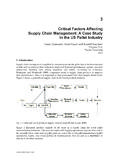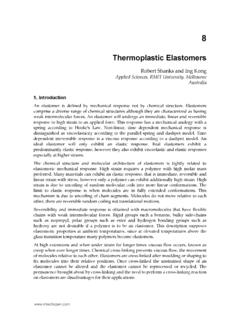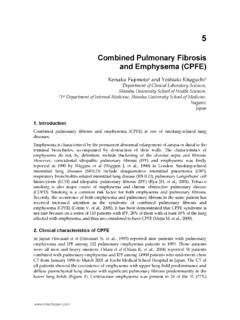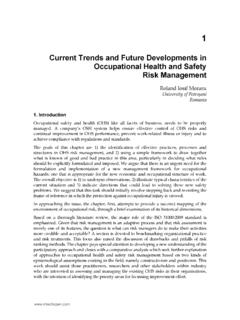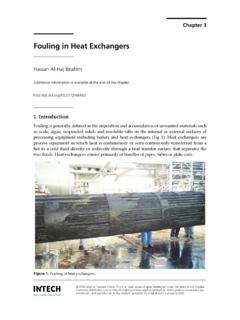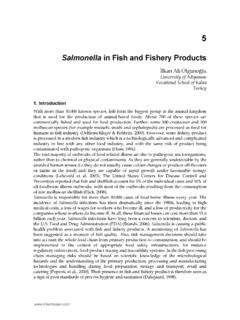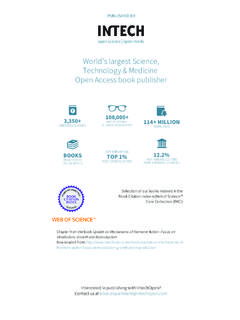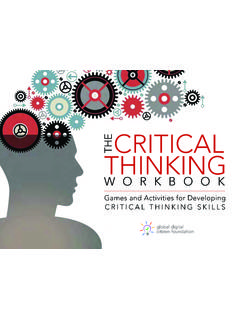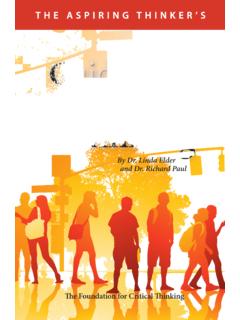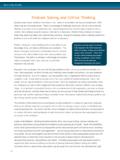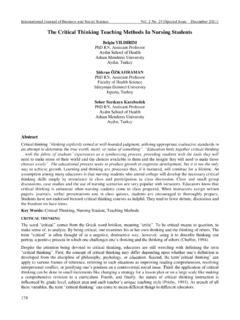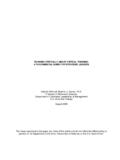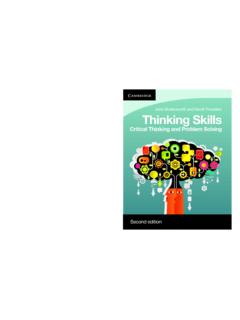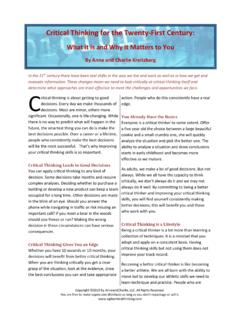Transcription of Critical Thinking Skills for Intelligence Analysis - Open
1 10. Critical Thinking Skills for Intelligence Analysis Douglas H. Harris and V. Alan Spiker Anacapa Sciences, Inc. USA. 1. Introduction Whether performed by national agencies or local law enforcement, the ultimate objective of Intelligence Analysis is to develop timely inferences that can be acted upon with confidence. To this end, effective Intelligence Analysis consists of integrating collected information and then developing and testing hypotheses based on that information through successive iterations of additional data collection, evaluation, collation, integration and inductive reasoning. The desired end products are inferences that specify the who, what, when, where, why and how of the activity of interest and lead to appropriate actions.
2 This process is illustrated in Figure 1. An a lysis Data Data Collection Integration Data Inductive Inferences Actions Evaluation Reasoning Data Hypothesis Collation Development Fig. 1. The Intelligence process While in the last couple of decades a number of useful tools have been developed to aid in data collection, evaluation, collation and integration, Analysis remains highly dependent on 210 Ergonomics A Systems Approach the cognitive capabilities, specifically the Critical Thinking Skills , of the human analyst. For this reason, it is important to understand the inherent capabilities and limitations of the analyst and, in particular, the cognitive challenges of Intelligence Analysis that must be overcome through training in and application of Critical Thinking (Harris, 2006a, 2006b.)
3 Heuer, 1999; Moore, 2007). Our concern with and study of Critical Thinking Skills for Intelligence Analysis relates to that aspect of ergonomics research that seeks to understand how people engage in cognitive work and how to develop systems and training that best support that work. These efforts have come to be known as cognitive ergonomics or cognitive engineering. While our focus here is specifically on the domain of Intelligence Analysis , we recognize the many areas of endeavor that require Critical Thinking Skills . These include the professions, business, military, education, and research and development. Just what is Critical Thinking ? Critical Thinking was first conceived in the early 1940's by two psychologists, Goodwin Watson and Edward Glaser.
4 Watson and Glaser also developed the first test of the skill, the Watson-Glaser Critical Thinking Appraisal (Watson & Glaser, 1980), which is still widely used. Since then, almost all of the theoretical development has been conducted by educators and philosophers, where the focus has been on identifying people with superior Critical Thinking aptitudes through testing. The notion of Critical Thinking as a skill that can be improved through focused training, as is the view of a psychological construct, has received far less attention. However, see Halpern (1996) and Baron and Sternberg (1986) for notable exceptions. In desiring to develop a consensus definition, the American Philosophical Association attempted to develop such a definition based on the responses of 46 experts (American Philosophical Association, 1990).
5 The resulting definition was purposeful, self-regulatory judgment which results in interpretation, Analysis , evaluation, and inference, as well as explanation of the evidential, conceptual considerations upon which that judgment is based. A review of the literature covering the 10 years subsequent to that exercise (Fischer & Spiker, 2000) revealed many different conceptions of Critical Thinking with only a modest degree of overlap. It appeared that the concept of Critical Thinking could not be adequately addressed by a simple verbal definition. A more comprehensive model was required to address important components and interactions, and to serve as a basis for empirical testing.
6 2. Model of Critical Thinking Critical Thinking has not endured the kind of empirical inspection typically bestowed upon constructs developed by psychologists. Its relationship to other, well-established psycho- logical constructs such as Intelligence , working memory, and reasoning, for example, has rarely been studied. It is the authors' admittedly subjective opinion that the lack of empirical study of Critical Thinking and its relationship to other individual difference dimensions has produced a fractionated view of the construct. Without the grounding of data, theorists have been free to postulate divergent concepts. An effort in philosophy to reach a consensus definition in 1990 had little effect on unifying the field.
7 To fill this gap, Fischer and Spiker (2004) developed a model that is sufficiently specific to permit empirical testing. The model identifies the role of Critical Thinking within the related Critical Thinking Skills for Intelligence Analysis 211. fields of reasoning and judgment, which have been empirically studied since the 1950s and are better understood theoretically. It incorporates many ideas offered by leading thinkers ( , Paul & Elder, 2001) in philosophy and education. It also embodies many of the variables discussed in the relevant literature ( , predisposing attitudes, experience, knowledge, and Skills ) and specifies the relationships among them. The model can, and has been, used to make testable predictions about the factors that influence Critical Thinking and about the associated psychological consequences.
8 It also offers practical guidance to the development of systems and training. An overview of the model's main features is provided here following a brief review of current Thinking about reasoning and judgment, on which the model is based. Dual system theory of reasoning and judgment Prior to the early 1970's, the dominant theory of decision making stated that people made judgments by calculating (1) the probability and (2) the utility of competing options. Although this rational-choice model took on a variety of forms, all versions posited a rational actor who made calculations of probability and/or utility, and selected the option that had the highest value. In the 1950's, however, researchers began to notice that the model failed to predict actual behavior (Meehl, 1954; Simon, 1957).
9 Evidence that falsified the rational choice theory accumulated over the following decade. In the early 1970s, an alternative theory proposed that people use heuristics, as opposed to the rational weighing of relevant factors, to make judgments. The new theory was, and continues to be, supported by empirical study (Baron & Sternberg, 1986). The heuristic theory states that many judgments are based on intuition or rules of thumb. It does not propose that all judgments are made intuitively, just that there is a tendency to use such processes to make many judgments. The most recent versions of heuristic theory, in fact, propose that two cognitive systems are used to make judgments (Kahneman, 2003).
10 The first system, intuition, is a quick, automatic, implicit process that been proposed to explain judgment. To accommodate the multiple theories, many researchers now use associational strengths to arrive at solutions. The other system, reasoning, is effortful, conscious, and deliberately controlled. Since the 1970's, multiple and similar two-process theories have referred to the implicit associational type of process as System 1, and the conscious delib- erate process, as System 2. The following example shows how these two processes may lead to different judgments. Suppose a bat and a ball cost $ in total. The bat costs $1 more than the ball. How much does the ball cost?
